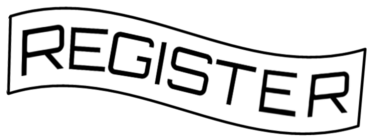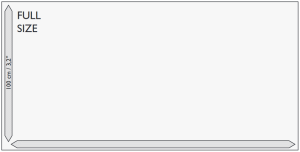Art Show >> Artist Guide
This is your comprehensive guide on how to prepare your artwork for display. There aren't many requirements, but some have to be met in order to keep the process smooth for everyone.
Technical Requirements
The Eurofurence Art Show provides panels and hooks for hanging art. The panels are sturdy wooden constructs with predrilled pegboard sides where hooks can be inserted. All panels are usable from both sides. See below for images!
The managers lay out the panels in the room to meet a number of requirements. The artists will normally not be able to request a certain layout (you can ask to be placed next to a friend; we try to honor these requests, but don't guarantee it). Panels are assigned.
To hang artwork, it must have a tab at the backside which fits the hooks. Please note that commercially available frames may come with tabs or holders that do not fit these hooks because they are designed for screws or nails. Eurofurence tries to make different hooks and additional clamp holders available; these will be on hand in limited numbers only, though. It is forbidden to paste the artwork to the panel with sticky tape or any other adhesive; this will ruin both the panel and the artwork.
Panels may be reserved in half-panel steps.
- a full panel will be 2m by 1m (6.56 by 3.28 feet)
- a half panel will be 1m by 1m (3.28 by 3.28 feet)
Please remember that the space you reserve must include some clearance between pieces, including space for the bid sheets. Your artwork may not extend beyond the edge of any panel. It may not interfere with any works displayed by other artists.
If you have never done this before, you can try the layout for your art at home: Arrange your framed and matted pieces on the floor, and try out what looks best. This will give you an idea of how much panel space you need to reserve. Look here for a sketch with example sizes: Panel Layout.
If you have extremely large pieces of art where a full panel would not suffice to hang it, or extremely heavy framing (wooden frame and glass) you need two people to lift, please contact the managers immediately so something can be worked out for that kind of artwork.
If you have three-dimensional artwork to display, you need a table instead of (or in addition to) a panel. The mail application will allow you to request tables. Since the tables are provided by the location, the sizes may vary. Please be prepared to change your setup according to final measurements. Note that the panels/tables are unprotected and open; if your art breaks easily, bring a showcase or a cover to discourage patrons who "look with their fingers". You are responsible for the protection of the artwork yourself.
Additional decoration of panels is restricted.
Panels are meant for the display of artwork, bidsheets and accompanying information. Draping the panels with cloth or paper as background or table-cloth is not allowed. Permanent changes to the panels, like paint, are of course strictly prohibited.
You may add artist information, like a box with business cards, to your panel. You may add small items as decoration, but any such items are displayed at the discretion of the Art Show managers, who may ask you to remove them if they do not fit in. (It is also not very polite to clutter panels with gadgets that take up space which may be used by other artists for their works.)
Due to fire hazard, it is not allowed to add any electrical appliance to the panel that runs on more than standard batteries. That concerns moving installations, lamps, and electronic displays.
The Eurofurence Art Show managers will try to fulfill all your needs in displaying your work. However, they cannot read minds, and not all requirements can be met on-site, so if you plan something special, get in contact with them as soon as possible.
Online Art Database
After application for the Art Show, you will receive your password and account data for the online art database once that goes online. Through the online system, you can enter your art data and create and print bidsheets. This data is also essential in the administration of the Art Show: it is the basic information on how much art we have, to whom it belongs, and how it is supposed to be handled.
Through that system, your receipts will be printed and your revenue will be calculated. Any data that is not entered before the con has to be entered at the con, which takes a lot of time. Thus, please register your art online ahead of the con, and help reduce waiting times at the con itself.
The online database comes with its own help system, so we will not repeat this information here.
Bidsheets and Selling Art
The Art Show allows you to sell your art. Please note that the show doesn't buy art, or sell art to bidders. The Art Show acts exclusively as a mediator in a contract between artist/owner and buyer (selling on commission with no fee).
Each piece of art will have a bidsheet attached (or have it hanging next to the piece) which provides information on the artwork, the artist, and more. The bidsheet is used for identification of the art, and for purchasing art. A piece of art is marked as "not for sale" by a special no-sale bidsheet that does not provide the purchase-related part.
If you don't want to sell your art, you simply use the no-sale bidsheet (you can mark a piece as not-for-sale in the online database, which will automatically select the correct bidsheet). This sheet still gives the visitor all necessary information about the art and the artist, but does not set a price or allow to bid on this piece.
If you want to sell your art, you use the sales bidsheet. Here, you need to state a minimum price, which is essentially the smallest sum you want to sell the piece for.
Bidsheets are available through the online database. If you do not have a printer available, you may print them at the convention; however, it is recommended that you print bidsheets before the con to avoid waiting times.
Visitors of the art show may bid on "for sale" pieces by writing their bid onto the corresponding bidsheet. The bid must meet the minimum price. The piece is sold to the highest bid at the end of the show. If the maximum number of bids are offered, the piece will be sold in the art show auction, which is a voice auction, and has no bidding limits.
After the auction (at a time to be announced at the convention), the art will be handed out to the customers, the money will be collected and finally given to the artists/owners. This is done for practical reasons: Eurofurence does not act as a buyer or reseller. The artists will receive the data of their buyers (and vice versa) to finalize the contract. Eurofurence will try to mediate in cases of problematic purchase, but it is up to the artist to verify and claim their money.
If artwork is sold but not collected and paid for by the bidder, we will try to notify the buyer of this mishap, and correct it before passing the money to the artist/agent. Should this not be possible, for example if the buyer has already left the convention, the artist or agent will be informed and provided with contact data to enable him/her to finalize the sale. Eurofurence cannot hand out money that has not been collected beforehand, and since the sales agreement is between the bidder and the artist/agent, Eurofurence cannot legally exact payment. The artist is free to take any measure to enforce the contract that has been concluded with the bidder.
Unsold pieces (having no bid) or "Not for sale" pieces are returned to the owner at the end of the art show.
Please note that any and all additional obligation like sales tax or income tax declarations have to be fulfilled by the artist/owner. Eurofurence assumes that the transactions are handled as private sales. If you are a (commercial) full-time artist, you may be required to file these sales properly, and to hand out the appropriate receipts to the customers.
Choosing Prices
The choice of a good minimum price is crucial for the sales. If your minimum is too low, you will be disappointed if the art sells for just that sum. If your minimum is too high, you may need to take it back because no one is willing to pay that initial price.
Some artists have tried to get their art into the auction by choosing very low minimum bids, since art in the auction may yield a higher price than in the regular bidding. However, in many cases that art still does not get the necessary number of bids to send it to the auction, and is sold for a low bid.
The Art Show managers cannot offer advice in choosing the minimum bid, since the buying behavior of the Eurofurence patrons often varies. Generally, you should ask yourself whether you really want to part with this piece for that minimum price, and still be comfortable with it. This depends largely on how you see your art: as a source to make prints from, as lovingly created unique pieces of art, as advertising for your commissions, as leisurely hobby, or as additional income.
Art Show Awards
For some years, Eurofurence has handed out awards for outstanding pieces. These awards consist of a prize ribbon which you can take home with you and display in your living room.
Four awards are handed out: Art Show Manager's Choice[1], Art Show Manager's Choice[2] (there are two art show manager, so there!), Chairman's Choice, and Guest of Honor Choice. Each award is selected by only that person, not by committee.
Since the prizes are awarded by very different people (the guest of honor even changing by the year), the criteria are various. Beyond technical prowess, graphic design, color choice, humor and originality are considered just as anatomy, perspective, depth, or expression are. The jurors may also take into account whether the piece comes as an original or just as a reproduction.
After the con, the awarded pieces are also displayed on the EF web site.
Art Show Images
How does the Art Show look? What are the "panels"? How will art be hung on the panel? Well, it's easier to show than to tell, and one image is worth 1000 words, so let's begin. Click on an image to get a larger version!
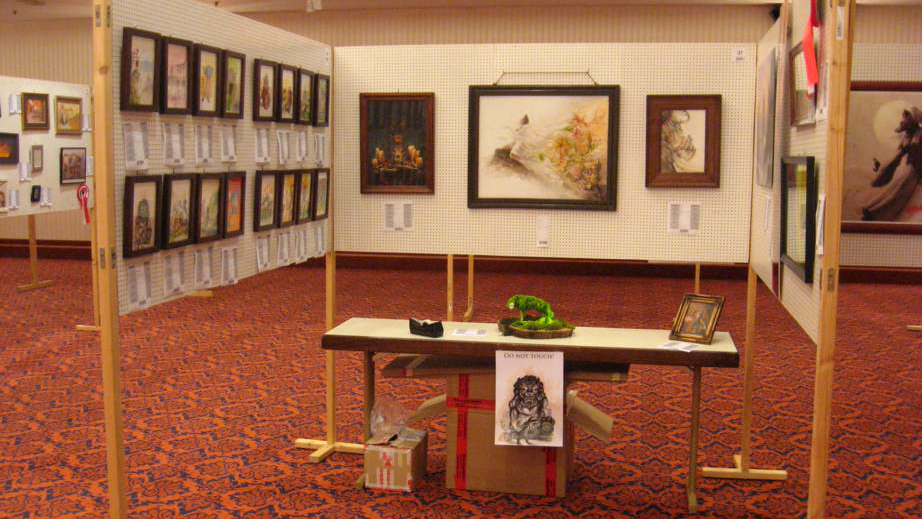
This is how a completed panel looks like. Many thanks to AlectorFencer for allowing us to use her setup. That is only one example how panels may be set up; the actual layout of the art show depends on the ratio of adult and general art, security and convenience issues, and technical factors.
You can see a complete nook with three panel sides and one table. Depending on the number of panels you got, you may have a nook or a wall for yourself, or you may need to share even the space on one single panel with someone else. There are also panels available of half the width, which you normally just get if you have only half a panel (or less) in total.
You can not influence the layout of the Art Show or the placement of your panel(s) beyond the separation of adult and general art. The panels are distributed among artists in a way that keeps artists' panels together. You can contact us if you have special needs; we will try to help you to realize your creative ideas. No guarantees can be given however.
Tables can be placed in nooks. Note that the table offers less space than the panel, but is the only way to display 3D art that cannot be hung. There is no showcase for your art, so if you have delicate art that must not be touched, better bring a protective showcase with you. It is not allowed to touch the art, but we can't have eyes everywhere, and some people love to look with their fingers.
Please ignore the boxes under the table; we provide a separate space for your packing material that you want to give to the buyer.
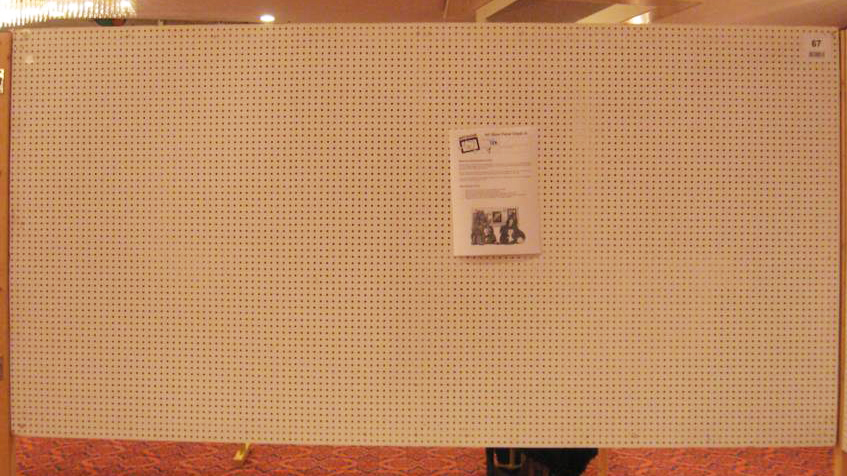
This is the empty panel that will greet you. The instruction sheet states your name and tells you what to do. Once you're done with the setup, you are asked to return this sheet with your signature and have an Art Show manager inspect your setup and check whether you follow the rules.
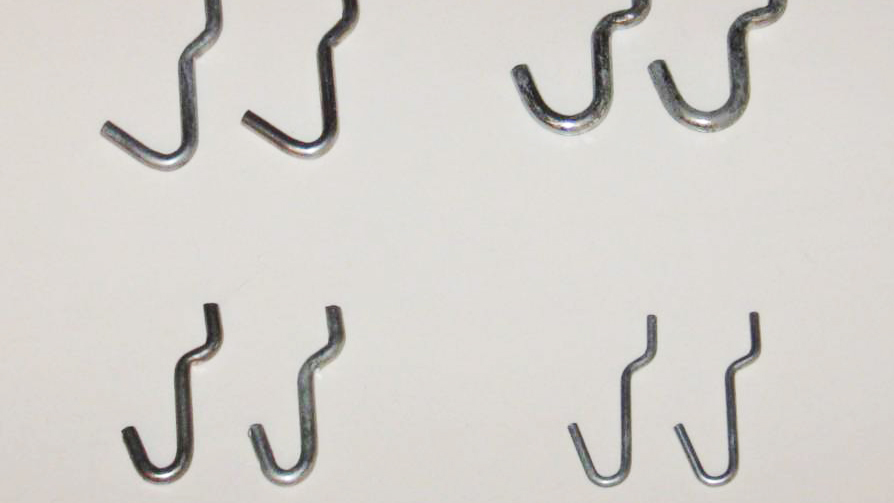
These are the hooks that are available to hang art. There are different sizes to allow for even large framed pieces to be hung.
The top part goes into the panel holes. No, they don't slide out. Some of the holes may be blocked by the construction frame behind it, but most are usable.
And no, you are not supposed to drill new holes, use nails, or glue your art to the panel. We love our panels, so please don't deface them.
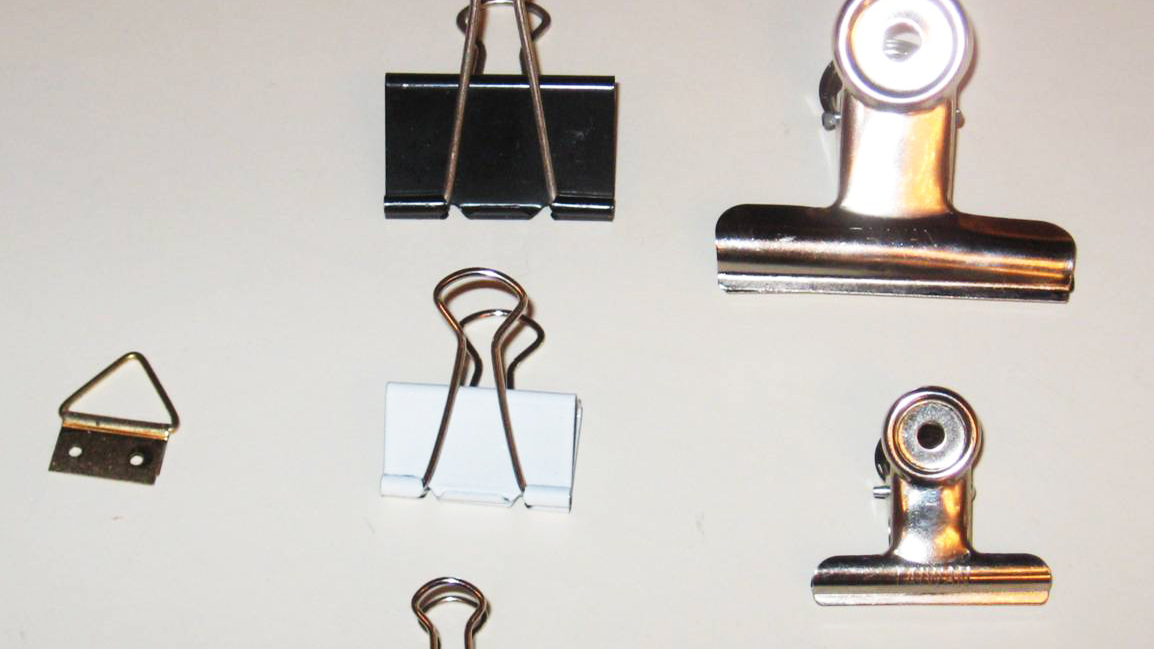
How can art be hung with these hooks? Obviously you need a bail / an eye on your frame. Most frames come with something like the eye on the left side, screwed to the upper frame. In cheap glass frames, the eye may be part of the connectors that hold glass front and backplate together. Make sure that your frame has an eye (or several) so you can hang it.
The clamps in the middle and to the right are what the EF Art Show can offer. These are meant for matted art — they will not hold anything heavier than a cardboard frame (art will slip out) but for these it works fine.
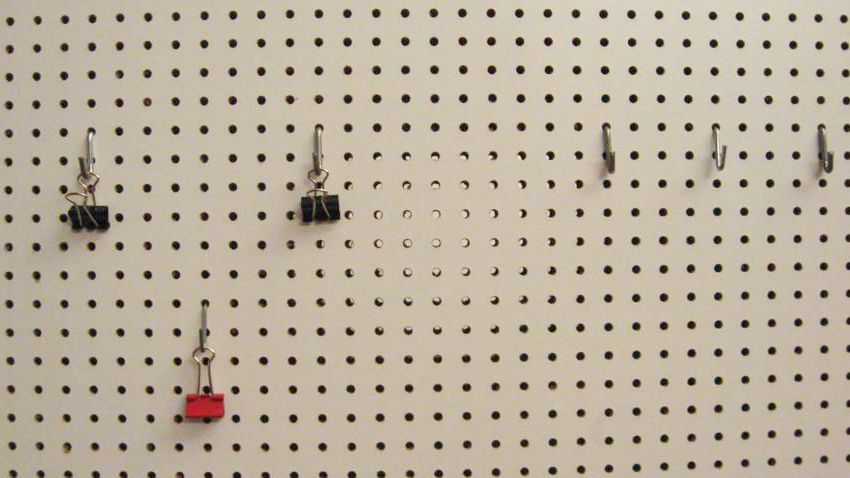
That's how it looks like on the panel.
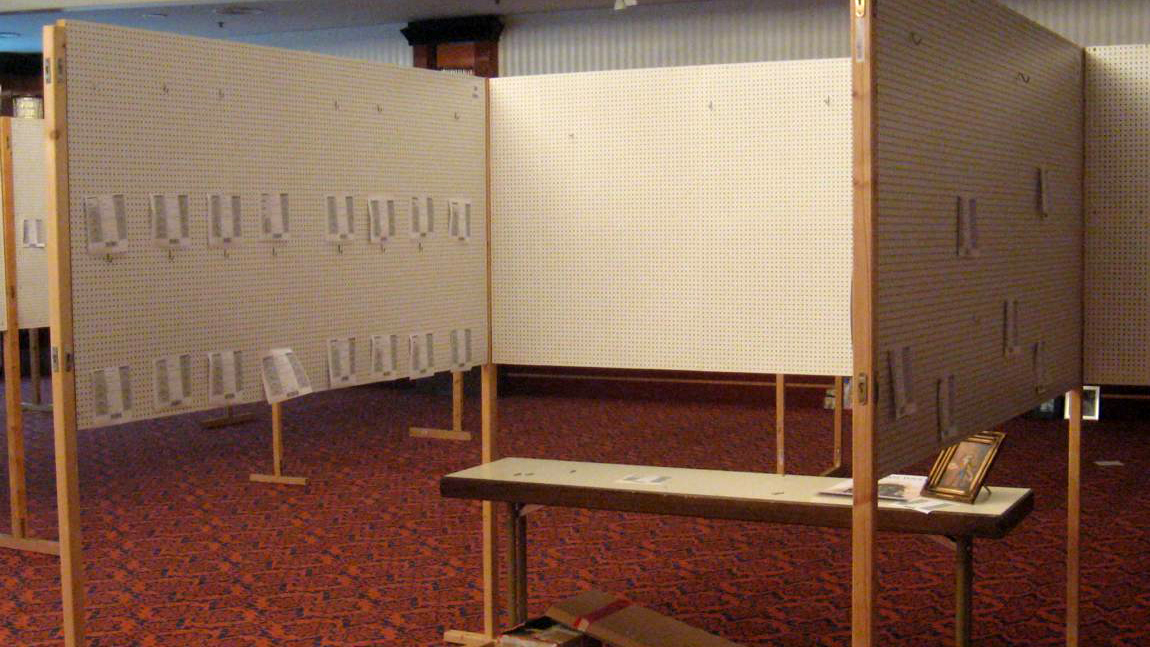
The white pieces of paper on the panel are the bidsheets. Each piece needs a bidsheet. As you can see, they are fairly large (smaller for art that is not for sale though), so you need to include them in your planned layout.
Without a bidsheet, your audience cannot bid or buy, so it's sort of important to have them.
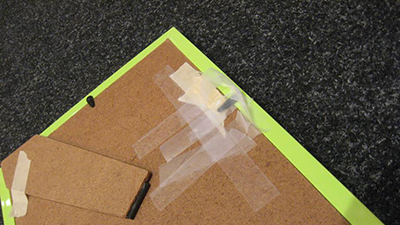
Example number one of what not to do. The unfortunate soul that tried to display this exhibit used adhesive tape instead of a proper eye. Of course, the piece fell down and had to be taken out of the show.
Obviously this is a standing frame, not a hanging frame — it has no provisions to hang at all. You can use these frames only on a table. Otherwise, you need to screw an eye on the frame. Adhesive tape does not work.
Please note that we cannot fix your frames for you during the show, nor do we have the tools to drill and screw frames.
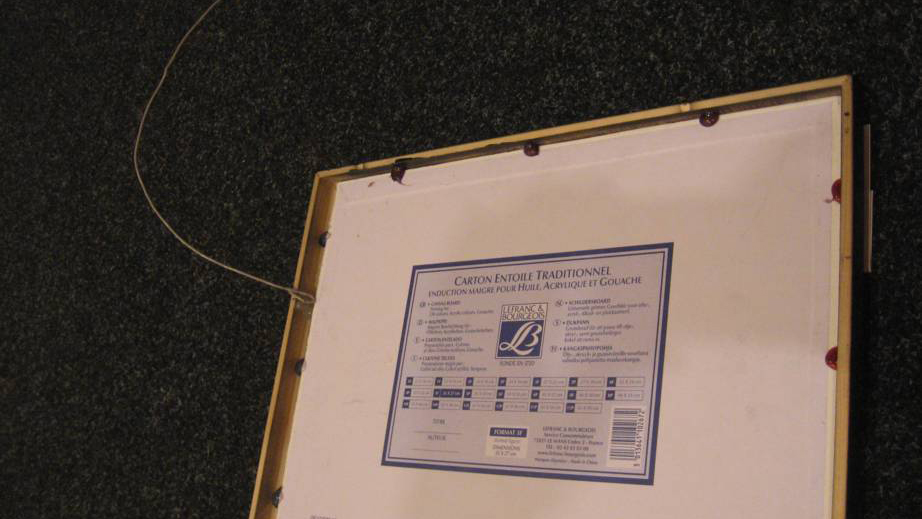
Example number two of what not to do. Hot-glueing a piece of wire doesn't work either, at least not on wood.
If you need to work with glue, please test the system at home. Remember, a panel may be rocked or shaken during the show, so "working just so-so" is not good enough. The hanging mechanism must be sturdy enough to survive a certain degree of rough handling.
And that's it! Thank you for your consideration in preparing art for the show, it makes the setup so much smoother and faster if you just need to grab a hook and hang a piece.
Please consider that while we are in a city, you may not be able to buy a fitting frame on location, especially if you need one for a foreign aspect ratio. Prepare the frame as well as the art. If you come a long way, we do recommend mat frames for easy transport, but be aware of stubbed corners.
Remember: A clear plastic binder sheet is not a frame! Respect your art, and grace it with a mat frame at least.
 AUG 22, 2018
AUG 22, 2018 AUG 26, 2018
AUG 26, 2018
